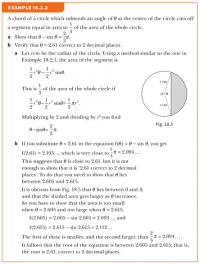StarFriedTree
New member
- Joined
- Oct 10, 2021
- Messages
- 7
If r = 1, I'd say
your answers are correct, but I'd love to know the process of ur solution.
If r = 1, I'd say
a.) 1.61076727304 ...
b.) 0.3154723876 ...
as if i dont know how to subtract triangle-areas from sector-areas. have been familiar with that thing for years now but it aint helping me solve [math]{\pi\over10 } = \theta -sin(\theta)[/math]Type into a search engine, "area of segment". And then think about how this can help you.
Please note that this is a math help forum, not a "guess the extent of my math knowledge" forum.as if i dont know how to subtract triangle-areas from sector-areas. have been familiar with that thing for years now but it aint helping me solve [math]{\pi\over10 } = \theta -sin(\theta)[/math]
If you had followed the rules and shown that you got that far and had trouble doing more, you would have had an answer almost immediately!as if i dont know how to subtract triangle-areas from sector-areas. have been familiar with that thing for years now but it aint helping me solve [math]{\pi\over10 } = \theta -sin(\theta)[/math]
tyIf you had followed the rules and shown that you got that far and had trouble doing more, you would have had an answer almost immediately!
This kind of equation can't be solved algebraically. It needs some numerical method. The easiest way is with software. For example,
x-sin(x)=pi/10 - Wolfram|Alpha
Wolfram|Alpha brings expert-level knowledge and capabilities to the broadest possible range of people—spanning all professions and education levels.www.wolframalpha.com
In case you plan to ask for help again, please read and obey:
READ BEFORE POSTING
Welcome to FreeMathHelp.com! Please take the time to read the following before you make your first post. It will help you to get your math questions answered promptly and in the most helpful manner. A summary is available here, but please read the complete guidelines below at your earliest...www.freemathhelp.com
What is the ISBN of your book?ty
i was hoping for a method that doesn't lead to this equation and allows me to attempt the question only with algebra, basic geometry and trigonometry. The question is from a math textbook, in the first exercise of the chapter titled "Radians", making me assume that there must be a simpler way to perceive and solve it.
i'll try to be more informative regarding the various stuff in my future queries, thank you
ISBN-13: 978 0 521 69637 lBeer induced query follows.
What is the ISBN of your book?
I located this exercise at https://books.google.com/books?id=OEyeDAAAQBAJ&pg=PA288ISBN-13: 978 0 521 69637 l
its Advanced Level Mathematics: Pure Mathematics 1 by Hugh Neill and Douglas Quadling. Exercise 18A

thank you. I actually eliminated all thoughts of doing it with 'successive approximations' (a new term for me but not a new concept) because it felt very crude and improper.I located this exercise at https://books.google.com/books?id=OEyeDAAAQBAJ&pg=PA288
On page 286 there is an Example 18.2.2 that shows how to solve such a problem by successive approximations. That is presumably what you are expected to do:
View attachment 29202
Your statement, "have been familiar with that thing for years now", suggests that you did not come across the problem while reading the book for a course you are taking, but out of context somehow. Context helps.
